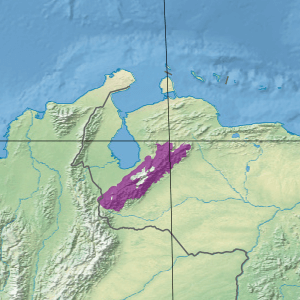Venezuelan Andes Montane Forests Ecoregion (Venezuela)
The Venezuelan Andes montane forests ecoregion is located in the northern arm of the Venezuelan Andes. Surrounded by xeric valleys and páramo, the richness of species and a large number of endemic species make this one of the most interesting areas of Venezuela in terms of biodiversity.
Venezuelan Andes Montane Forests
The Venezuelan Andes montane forests ecoregion is located in the northern arm of the Venezuelan Andes, which is the northeastern branch of the Andes Mountain system, separated from the Eastern Andes of Colombia by the Tachira depression at the border between Colombia and Venezuela.
The Venezuelan Andes montane forest also includes those forests around Tamá Massif, a relatively isolated montane area between the Eastern Andes of Colombia and the Táchira depression.
To the southeast, it adjoins the Llanos and the Apure-Villavicencio dry forests, and to the southwest borders the Cordillera Oriental montane forests. To the northwest, it adjoins the Catatumbo moist forests and the Maracaibo dry forests. Finally, to the north, it merges into Paraguana xeric scrub and La Coast xeric shrublands.
The Venezuelan Andes montane forest ecoregion occupies montane forests at middle elevations:
-
The evergreen transitions forests can be found at 800 - 2,000 m (2,600 - 6,600 ft) and have dense middle-high vegetation mainly from the Lauraceae, Moraceae, Myrtaceae, Bignomiaceae, Euphorbiaciae, and Araliaceae families.
-
The evergreen montane cloud forests occur at 2,000 - 3,000 m (6,600 - 9,800 ft) and are tall forests with an abundant understory. Dominant species include pino de pasto, Mexican alder, Ruagea glabra, Oreopanax moritzii, and Weinmannia jahnii.
The climate is strongly influenced by the northeastern trade winds, especially during the dry season, from December to April. From April to November, the inter-tropical convergence zone brings the highest rainfall of the year. Annual rainfall is roughly 2,000 - 3,000 mm (80 - 120 in) but can vary.
Flora and Fauna
Surrounded by inter-Andean xeric valleys and páramo, the high richness of plant and animal species and many endemic species make this ecoregion one of the most interesting areas of Venezuela in terms of biodiversity.
The regional flora of the Venezuelan Andes is extraordinarily diverse. Vegetation includes evergreen transition forests between 800 m (2,600 ft) and 1,800 - 2,000 m (5,900 - 6,600 ft) and evergreen cloud forests higher up.
The evergreen transition forests are dense, with two or three layers, with most trees of the families Lauraceae, Moraceae, Myrtaceae, Bignoniaceae, Euphorbiaceae and Araliaceae. From 2,000 - 3,000 m (6,600 - 9,800 ft), there are very dense cloud forests with two or three layers, many epiphytes and a rich understory.
There are 25 restricted-range endemic bird species in the Venezuelan Andes ecoregion. Four endemic mammals are present in the Venezuelan Andean montane forests ecoregion: a marsupial (Gracilinanus dryas), a bat (Anoura luismanueli), a rat (Thomasomys vestitus) and a poorly known fish-eating rat, (Neusticomys mussoi). In addition, there is a significant number of endemic frogs.
A species of particular concern is the spectacled Bear (Tremarctos ornatus), an endangered mammal with wide distribution in the Andes, from Colombia and Venezuela to Ecuador, Peru and Bolivia.
Protection Status
The expansion of agriculture into this region represents the most significant threat to this fragile ecosystem. Most of the slopes have had their native habitat converted for agricultural purposes. This has given the ecoregion’s montane forests a mosaic and patchwork appearance.

Map depicting the location of the Venezuela Andes montane forests (in purple)
